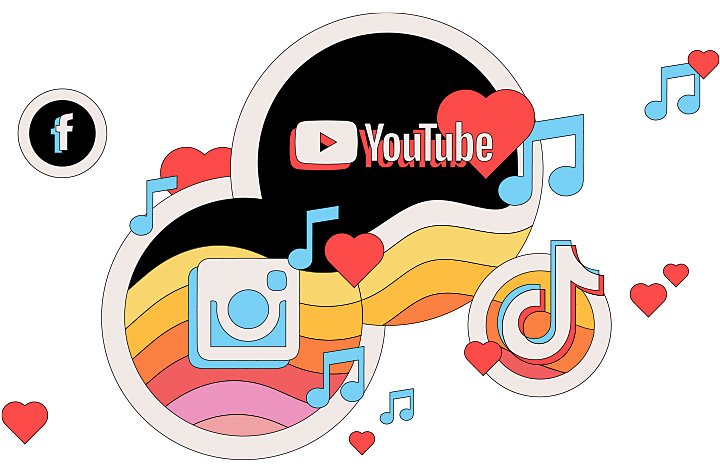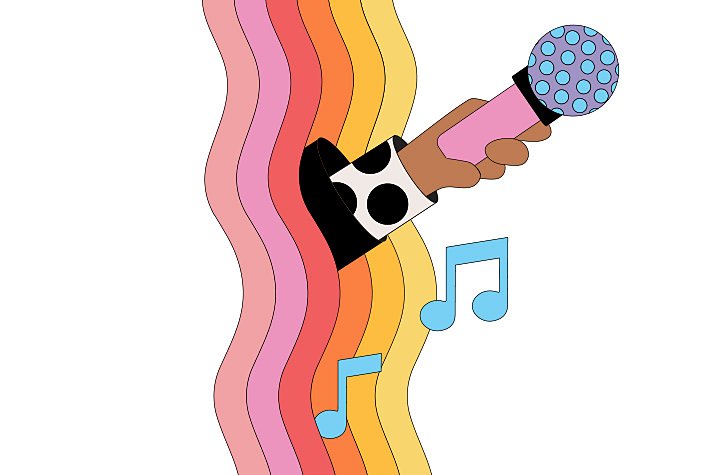How to use sound to enhance your social media posts
Hook your viewers with catchy music, sound effects, and vocals to amp up social media engagement.

Social media is an essential tool that can help businesses and individuals alike share content and connect. But people are active on so many different platforms that it can be difficult to cut through the noise and connect with users. Of course, social media’s popularity also means you have the opportunity to engage a large audience — if you can get users to listen to your message.
To make your voice heard, adding audio content may be exactly what you need. With sound, you can connect with users through two of their five senses, instead of sight alone. And when sound is half of the entire user experience, this is an incredibly valuable way to boost audience engagement on social media.
How audio boosts social media engagement.
Though audio can be a powerful tool for social media engagement, you have to be deliberate about how, when, and where you use it in order to reap its benefits. Generally, sound is strongest when paired with video, but depending on your content and the platform, audio may be captivating enough on its own. Here are a few ways audiences engage differently according to the social media platform:

- Facebook
Generally, audio is not the best way to engage Facebook users. According to Digiday, some 85% of users watch video without sound on Facebook. Plus, videos in the News Feed automatically play without sound, unless a user clicks on the video or changes their settings.
- Instagram
Photos and images are the most common types of content shared on Instagram, though Hubspot reports that videos receive twice the amount of engagement. Similar to Facebook, videos on Instagram posts will autoplay without sound and may not be the best avenue for audio. Per Instagram, Stories are a better option, since .
- TikTok
Well-known for its short video clips, TikTok has some of the highest rates of overall engagement, especially compared to other popular platforms. The company reports that music is integral to their content, with many songs gaining just as much popularity on the charts as they do on the app itself.
- YouTube
Because the entire platform revolves around video content, sound is crucial for engagement on YouTube. According to Business Insider, as many as 96% of users watch YouTube videos with sound. Simply put, if you’re going to make a YouTube video, you’ll need some kind of audio.
A user’s location, and possibly their device, can also influence engagement with audio content, regardless of the platform. In a survey conducted by Verizon, 69% of respondents watched videos without sound when they were in public spaces. Only 25% of respondents viewed video without sound when in a private place. Mobile users are more likely to watch soundless videos because they are in public and feel like audio isn’t an option. Desktop users, on the other hand, have more of a choice about how they watch videos, making them more likely to turn the sound on.

Types of audio to include in your social media posts.
You can’t control where users are or what devices they use when they watch your videos, but you can control what they hear if they choose to interact with your content. That being said, one of the biggest factors influencing user engagement is the type of audio used.
Simply to include audio is not enough — you have to include the right kind to reach users effectively in order to hear the sweet sounds of marketing success. The main types of audio you can use include:
- Vocals
This refers to the human voice, including voiceover, singing, narration, and dialogue between multiple people. Ranging from detailed explainer videos to casual video blogs, vocals are used frequently in social media content.
- Sound effects
A sound or audio effect is any artificial or manufactured sound that emphasizes or punctuates video content. They are often created with Foley, but you can also find libraries of stock sound effects.
- Music
Music may be the driving force behind a piece of content, like in a music video, but it can also be used as background music on a site or page, similar to a soundtrack.
You aren’t limited to using a single kind of audio in your content. Try using multiple types of audio to keep users engaged. It may not be exciting, for instance, to listen to two people talk for too long, but adding some music can make the video more interesting and engaging for your viewers.
How to incorporate sound into your social media posts.
Compared to developing your audio brand in the first place, adding sound to your social posts is relatively simple:
Invest in good audio equipment.
Above all, you need good audio equipment to capture sound for your content. It doesn’t matter how good the sound is if you can’t adequately record it.
If you’re going to start recording regularly, you’ll probably want to invest in:
- A computer
- A microphone
- A microphone stand
- A digital recorder
- Headphones
- An audio interface
- Studio monitors
- A pop filter
- Sound-proofing materials
- Storage devices or memory cards
Equipment doesn’t just include your hardware — you’ll also need recording software, as well as audio and video editing software.
Keep in mind that this is just to get you started, especially if you’re working in a home studio. Depending on what kinds of sounds you want to record, you may need additional or specialized equipment. For instance, if you’re making a podcast, you’ll need different equipment than someone who’s recording music. As time goes on, you’ll get a better sense of what else you need.

Properly recording your audio.
Once you have your setup ready, you need to record your audio. To get great sound, you need to record great sound. You can brush off unwanted noises or enhance the quality after the fact, but it’s always best to start with a high-quality recording.
Do your best to record somewhere quiet and minimize any ambient noises, like nearby traffic. Sounds that you wouldn’t notice in a normal conversation, such as the wind or an echo, can be highly distracting in a recording. Take a short recording of the surrounding background noise, as this can help the editing process go more smoothly.
It takes some finessing, but make sure the speaker, music, or sound being recorded is appropriately distanced from the microphone. You need a strong and clear, but not overpowering, sound. If the sound is loud and close to the mic, it’ll push the audio levels up too high. If it’s too soft or far away, you’ll pick up background noise.
Even the best recordings can benefit from a bit of editing. Despite your efforts, there’s probably some ambient noise or dead air that needs to be removed. You may even want to add in some sound effects or background music to add more punch. You’ll also need to look at more technical factors, like the bitrate and file format of your recording, that can affect the quality of your audio and your ability to share it on social media. Simply compressing the audio can go a long way in polishing your recording.
It takes time to learn how to edit, as well as to decide on your personal preferences. There is no single right or wrong way to edit — it all depends on what you’re trying to create with your finished product.
Make sure audio is perfectly synced to your video.
As you begin incorporating your audio and video, make sure they are in perfect alignment. Be certain that people’s mouths match the words they’re saying, noises happen when they’re supposed to, and music is properly cued.
A video with audio that’s a few milliseconds off may not seem like a big deal at first glance but ultimately, it is. Viewers will notice and be distracted by a video that has out-of-sync audio, especially when someone is talking. When you only have seconds to catch users’ attention, it’s worth making sure your audio and video are synced.
Finally, add captions to your video before posting it. Captions make your content more accessible to a greater number of users. Consider including captions or subtitles in multiple languages for an even broader reach.
Furthermore, captions could help increase your overall viewership. As Verizon states in their report, 80% of users are more likely to watch a video in its entirety if it has captions. At the end of the day, captions help enrich the experience users have with your content, whether or not they also watch it with sound.
Experiment often.
Using audio on social media is more of an art than a science. People’s preferences change quickly and frequently, making it difficult to predict what kind of content will capture their attention. Don’t be afraid to experiment, as it may take some trial and error to find something that works for you and your users.
Do more with Adobe Premiere Pro.
Make visually stunning videos virtually anywhere — for film, TV and web.
You might also be interested in…
The best music video editing apps.
Create simple compilations or complex HD music videos with Adobe Premiere Rush and Premiere Pro.
Add multiple audio tracks from voiceovers to sound effects to a video file.
A beginner’s guide to frame rate.
Learn the fundamentals of frame rate to make sure your footage looks perfect.
Reduce the size of a video file with Adobe Media Encoder.
Find out how to reduce the size of video files without reducing quality.
Get Adobe Premiere Pro
Create flawless productions with the industry-leading video editing software.
7 days free, then £21.98/mo.



